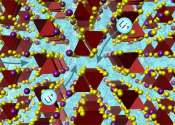Discovery of new Li ion conductor unlocks new direction for sustainable batteries
One of the grand challenges for materials science is the design and discovery of new materials that address global priorities such as Net Zero.
Feb 15, 2024
0
111
Energy & Green Tech

One of the grand challenges for materials science is the design and discovery of new materials that address global priorities such as Net Zero.
Feb 15, 2024
0
111
Energy & Green Tech

Despite the many potential applications of seawater batteries (SWBs), the limited performance of available materials has hindered their commercialization. To tackle this issue, scientists from Korea Maritime and Ocean University ...
Feb 1, 2022
0
80
Energy & Green Tech

Due to the worldwide growth of electric vehicles, there has been a rise in demand for next-generation secondary batteries with higher capacity and faster charging than the lithium-ion batteries currently in use. Lithium metal ...
Mar 27, 2023
0
31
Energy & Green Tech

Anybody who has ever enjoyed fresh crab legs or lobster tails can attest to how difficult it is to get through their tough shells. But instead of just throwing them away, researchers are "upcycling" these shells into porous, ...
Mar 13, 2023
0
190
Energy & Green Tech

Lithium ion batteries have already become an integral part of our everyday life. However, our energy-hungry society demands longer life, faster charging, and lighter batteries for a variety of applications from electric vehicles ...
Apr 21, 2020
0
621
Energy & Green Tech

The cost of harvesting solar energy has dropped so much in recent years that it's giving traditional energy sources a run for their money. However, the challenges of energy storage—which require the capacity to bank an ...
Apr 5, 2021
2
1346
Energy & Green Tech

Scientists have spent decades searching for a safe alternative to the flammable liquid electrolytes used in lithium-ion batteries.
Dec 15, 2016
0
1304
Energy & Green Tech

Solar energy is at the forefront of the global shift toward producing sustainable energy sources and addressing energy poverty. However, the intermittent nature of solar energy limits its use for applications such as IoT ...
Energy & Green Tech

Scientists at Lawrence Berkeley National Laboratory (Berkeley Lab) have developed a conductive polymer coating—called HOS-PFM—that could enable longer lasting, more powerful lithium-ion batteries for electric vehicles.
Mar 7, 2023
0
27
Energy & Green Tech

Researchers have successfully increased the lifespan and stability of solid-state lithium-ion batteries, creating a viable approach for future widespread usage.
Jun 8, 2022
0
132
An ion is an atom or molecule where the total number of electrons is not equal to the total number of protons, giving it a net positive or negative electrical charge.
Since protons are positively charged and electrons are negatively charged, if there are more electrons than protons, the atom or molecule will be negatively charged. This is called an anion (pronounced /ˈænaɪən/; an-eye-on), from the Greek ἀνά (ana), meaning 'up'.
Conversely, if there are more protons than electrons, the atom or molecule will be positively charged. This is called a cation (pronounced /ˈkætaɪən/; cat-eye-on), from the Greek κατά (kata), meaning 'down'.
An ion consisting of a single atom is called a monatomic ion. If it consists of two or more atoms, it is called a polyatomic ion. Polyatomic ions containing oxygen, such as carbonate and sulfate, are called oxyanions.
When writing the chemical formula for an ion, its charge is written as a superscript '+' or '−' following a number indicating the difference between the number of protons and the number of electrons. The number is omitted if it is equal to 1. For example, the sodium cation is written as Na+, the '+' indicating that it has one less electron than it has protons. The sulfate anion is written as SO42−, the '2−' indicating that it has two more electrons than it has protons.
If an ion contains unpaired electrons, it is called a radical ion. Just like neutral radicals, radical ions are very reactive.
This text uses material from Wikipedia, licensed under CC BY-SA